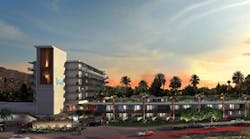When the Hotel Valley Ho opened in Scottsdale, Ariz., in 1956, it quickly became the preferred destination for celebrities. It was a vacation spot for Janet Leigh and Tony Curtis. Jimmy Durante played the piano in the lobby. Natalie Wood and Robert Wagner hosted their private wedding reception there. Sometimes referred to as the “Baby Biltmore,” the Valley Ho building, a crescent-shaped, two-story wing of hotel rooms, suggested the influence of Frank Lloyd Wright. The interior rooms maintained a swank bachelor-pad décor while the pool courtyard was a modernist paradise.
Unfortunately, the slick modernism didn't survive. The hotel was headed for foreclosure until Westroc partners Bill Nassikas and Scott Lyonas bought it in May 2002 and began the process of returning the structure to its original glory. When the hotel reopens in December, it will boast a new two-story wing, pools and spas, restaurants, and outdoor flame and water features. On board for the restoration and 220,000-square-foot expansion of the 14-acre property were Phoenix-based Kitchell Contractors, the original builder on the hotel, and Hatfield Reynolds Electric, the design/build electrical subcontractor.
To have the hotel open for Scottsdale's prime tourist season (around Christmas), the contractors had to work within a 14-month construction schedule. That tight of a timeline is difficult under even the most optimal specifications, but the hotel posed another challenge. The Valley Ho is the only hotel on the Scottsdale Historic Register, meaning that both the rehabilitation of the existing structure and the addition had to stay in the spirit of the original design, yet follow contemporary energy-efficiency and safety standards.
For Hatfield Reynolds Electric, a subsidiary of Integrated Electrical Services, Inc., that meant wiring around existing 50-year-old structures, such as the exposed brick walls in the interior. According to Ralph Buehler, project manager, the electricians sometimes drilled to get inside the brick, but in most cases the firm reused existing underground utility tunnels by stripping out the original conduit and wiring and installing new supports, conduit, and wiring. Where the tunnels didn't reach, surface-mounted wiring methods were used to complete the circuit paths. In the end, the company installed more than 24 miles of conduit, 139 miles of wire, and 3,000 receptacles and switches. It also prepared the facility for low-voltage networking and audiovisual systems and added the first fire-alarm system in the hotel's history.
Lighting posed its own retro versus retrofit challenge. In the addition to the hotel, the electrical contractor had to find and install lighting fixtures to fit in with the mid-20th-century décor. In the new ballrooms, Hatfield Reynolds also installed a dimming system and skyhooks for a theatrical lighting system and prepared the rooms for audiovisual lighting effects, high-definition flat-screen TVs, built-in workstations, and WiFi and cable modem connectivity by installing the necessary conduit. In areas of the existing structure, Hatfield Reynolds had to refurbish the existing light fixtures to comply with today's energy codes. Lights were relamped to change from high-energy use incandescent bulbs to more efficient screw-in fluorescents. Working around the original structure also proved difficult in this area. In one instance, electricians installed recessed light fixtures in 12-inch thick concrete ceilings. “The biggest challenge was rerouting wiring and installing wiring and conduit to certain areas and then rerouting them again around existing architectural details,” Buehler says.
Sidebar: The Advantage of Design/Build
Hatfield Reynolds credits its design/build status on this one-of-a-kind project as a key factor in being able to perform the unique installation in such a short amount of time. “It gave us a lot more flexibility, and coordination time between trades was a lot quicker,” says Ralph Buehler, project manager. “We didn't have the typical long process for submittals and requests for information because we were part of the overall design team.”
Even though some of the design elements worked out on paper, the team still met with several obstructions in the field, especially when working around the original architectural details of the facility. However, because the company served as the design/build contractor, its first major job in this capacity, it was able to redesign onsite and resolve the situation very quickly, thus avoiding the sometimes-lengthy RFI process involving the engineers, architects, and owners.



